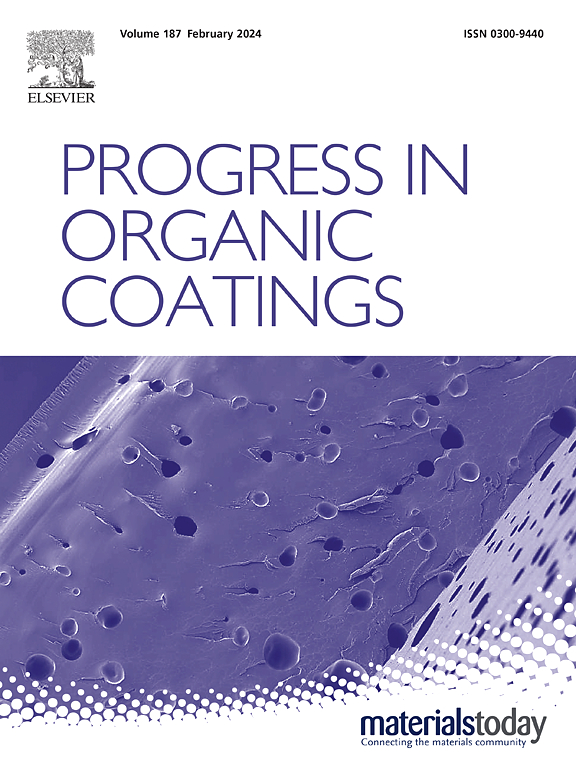High ethanol tolerance and Ca2+ stability polyacrylate latex binder for universal water-based inks constructed by active emulsifier and low acid value alkali soluble resin
IF 7.3
2区 材料科学
Q1 CHEMISTRY, APPLIED
引用次数: 0
Abstract
With the increasingly strict requirements for water-based ink printing quality and the expansion of application scenarios, dryness, adhesion, and levelling property have gradually become the printing industry's focus. This paper successfully synthesized a self-crosslinking polyacrylate latex stabilized by low acid value alkali soluble resins (ASR) and reactive emulsifier by pre-emulsification semi-continuous seed emulsion polymerization. Moreover, polyaryl polyoxyethylene sulfate ammonium salt (MORS-10) was used as an anionic reactive emulsifier, and crosslinking structure was constructed by diacetone acrylamide (DAAM) and adipic acid dihydrazide (ADH). The influence of reactive emulsifiers and low acid value ASR on the properties of polyacrylate latex was studied in detail. Compared to latex stabilized by ASR alone, and latex co-stabilized by ASR and sodium dodecyl sulfate (SDS), the latex stabilized by ASR and MORS-10 has better ethanol and Ca2+ stability, in particular, when MORS-10 accounts for 3 % of the monomer and ASR solids, there is no coagulum generated when diluted with anhydrous ethanol at the mass ratio of 1:1, and the resulting coagulum after mixed with 2 % CaCl2 to 40 % of the latex mass is negligible. Meanwhile, the adhesion of inks made of it all achieves 100 % on biaxially oriented polypropylene (BOPP), polyethylene terephthalate (PET), and aluminum foil. In addition, with the introduction of small molecule emulsifier, the redissolution of the ink is slightly improved, and SDS has a greater impact than MORS-10. The above findings provide a creative design idea and inspiration for the design of water-based ink binders with high stability and strong versatility.
以活性乳化剂和低酸值碱溶性树脂配制的通用水性油墨用高乙醇耐受性和高Ca2+稳定性聚丙烯酸酯胶乳粘合剂
随着人们对水性油墨印刷质量要求的日益严格和应用场景的扩大,干燥性、附着力、流平性逐渐成为印刷行业关注的焦点。采用预乳化半连续种子乳液聚合方法,成功合成了低酸值碱溶树脂(ASR)和反应性乳化剂稳定的自交联聚丙烯酸酯乳液。以聚芳基聚氧乙烯硫酸铵(MORS-10)为阴离子反应性乳化剂,以二丙酮丙烯酰胺(DAAM)和己二酸二肼(ADH)为原料构建交联结构。研究了活性乳化剂和低酸值ASR对聚丙烯酸酯乳液性能的影响。与单用ASR稳定的乳胶和ASR与十二烷基硫酸钠(SDS)共稳定的乳胶相比,ASR与MORS-10稳定的乳胶具有更好的乙醇和Ca2+稳定性,特别是当MORS-10在单体和ASR固体中所占的比例为3%时,用无水乙醇以1:1的质量比稀释时不产生凝块,用2%的CaCl2与40%的乳液质量混合后产生的凝块可以忽略不计。同时,用它制成的油墨在双轴取向聚丙烯(BOPP)、聚对苯二甲酸乙二醇酯(PET)和铝箔上的附着力达到100%。此外,随着小分子乳化剂的引入,油墨的再溶性略有改善,SDS比MORS-10的影响更大。以上发现为设计高稳定性、通用性强的水性油墨粘合剂提供了创造性的设计思路和灵感。
本文章由计算机程序翻译,如有差异,请以英文原文为准。
求助全文
约1分钟内获得全文
求助全文
来源期刊

Progress in Organic Coatings
工程技术-材料科学:膜
CiteScore
11.40
自引率
15.20%
发文量
577
审稿时长
48 days
期刊介绍:
The aim of this international journal is to analyse and publicise the progress and current state of knowledge in the field of organic coatings and related materials. The Editors and the Editorial Board members will solicit both review and research papers from academic and industrial scientists who are actively engaged in research and development or, in the case of review papers, have extensive experience in the subject to be reviewed. Unsolicited manuscripts will be accepted if they meet the journal''s requirements. The journal publishes papers dealing with such subjects as:
• Chemical, physical and technological properties of organic coatings and related materials
• Problems and methods of preparation, manufacture and application of these materials
• Performance, testing and analysis.
 求助内容:
求助内容: 应助结果提醒方式:
应助结果提醒方式:


